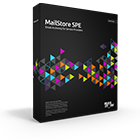Implementing an Application Integration Server
The following describes how to implement your own Application Integration server to synchronize users from sources that are not natively supported by MailStore. This can be virtually any user database that can be accessed via programming or scripting languages, for instance SQL server databases or plain text files. Using an Application Integration server as a directory service for synchronization and authorization in a MailStore SPE Instance is described in Instance Administration.
Application Integration servers can be written in any programming or scripting language. They must either provide their own HTTP server interface or be accessible through an existing HTTP server.
Synchronizing Users
The Application Integration server must accept the following parameter via HTTP POST request to initialize the synchronization.
| Name | Description |
|---|---|
| cmd | For synchronizing users the cmd parameter must be set to list. |
The returned HTTP response must contain valid JSON formatted data. When synchronizing users, the following data structure is expected for each user object. Multiple users must be returned as an array of JSON objects.
| Name | Type |
|---|---|
| userName | string |
| distinguishedName | string (optional) |
| fullName | string (optional) |
| emailAddresses | array (optional) |
Example
HTTP Request
POST /mailstore-integration/index.php HTTP/1.1
Authorization: Basic bWFpbHN0b3JlQGV4YW1wbGUudGVzdDpQYXNzdzByZA==
User-Agent: curl/7.22.0 (x86_64-pc-linux-gnu) libcurl/7.22.0 OpenSSL/1.0.1 zlib/1.2.3.4 libidn/1.23 librtmp/2.3
Host: mail.example.test
Accept: */*
Content-Length: 8
Content-Type: application/x-www-form-urlencoded
cmd=list
HTTP Response
HTTP/1.1 200 OK
X-Powered-By: PHP/5.4.4-14+deb7u5
Content-Type: text/json; charset=utf8
Date: Fri, 13 Dec 2013 14:20:27 GMT
Server: lighttpd/1.4.31
Content-Length: 23812
Accept-Ranges: none
Connection: Keep-Alive
[
{
"userName": "john.doe",
"distinguishedName": "UID=john.doe,DC=example,DC=com",
"fullName": "john.doe",
"emailAddresses": [
"[email protected]",
"[email protected]"
]
},
{
"userName": "jane.doe",
"distinguishedName": "UID=jane.doe,DC=example,DC=com",
"fullName": "jane.doe",
"emailAddresses": [
"[email protected]",
"[email protected]"
]
}
]
Authenticating Users
The Application Integration server must accept the following parameters via HTTP POST request to authenticate users.
| Name | Description |
|---|---|
| cmd | For authenticating users the cmd parameter must be set to auth. |
| user | The user parameter contains the user name to be authenticated. |
| pass | The pass parameter contains the password to be verified. |
The returned HTTP response must contain valid JSON formatted data. When authenticating users, the following data structure is expected.
| Name | Type |
|---|---|
| succeeded | boolean |
Examples
HTTP Request
POST /mailstore-integration/index.php HTTP/1.1
Authorization: Basic bWFpbHN0b3JlQGV4YW1wbGUudGVzdDpQYXNzdzByZA==
User-Agent: curl/7.22.0 (x86_64-pc-linux-gnu) libcurl/7.22.0 OpenSSL/1.0.1 zlib/1.2.3.4 libidn/1.23 librtmp/2.3
Host: mail.example.test
Accept: */*
Content-Length: 8
Content-Type: application/x-www-form-urlencoded
cmd=auth&user=john.doe&pass=Passw0rd
HTTP Response - Authentication Successful
HTTP/1.1 200 OK
X-Powered-By: PHP/5.4.4-14+deb7u5
Content-Type: text/json; charset=utf8
Date: Fri, 13 Dec 2013 14:20:27 GMT
Server: lighttpd/1.4.31
Content-Length: 21
Accept-Ranges: none
Connection: Keep-Alive
{
succeeded: true
}
HTTP Response - Authentication Failed
HTTP/1.1 200 OK
X-Powered-By: PHP/5.4.4-14+deb7u5
Content-Type: text/json; charset=utf8
Date: Fri, 13 Dec 2013 14:20:27 GMT
Server: lighttpd/1.4.31
Content-Length: 22
Accept-Ranges: none
Connection: Keep-Alive
{
succeeded: false
}
Example Server Implementations
Please understand that beyond this documentation no further support for the Application Integration Server examples are provided. Unless stated otherwise, these examples are released under the terms and conditions of the MIT License.
Python
An implementation of a modular Application Integration Server written in Python can be found in the Application-integration-server.zip file.
